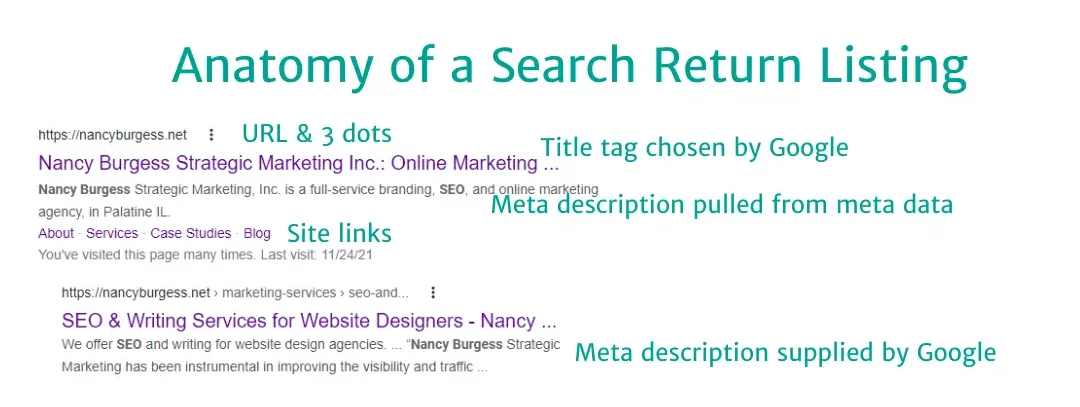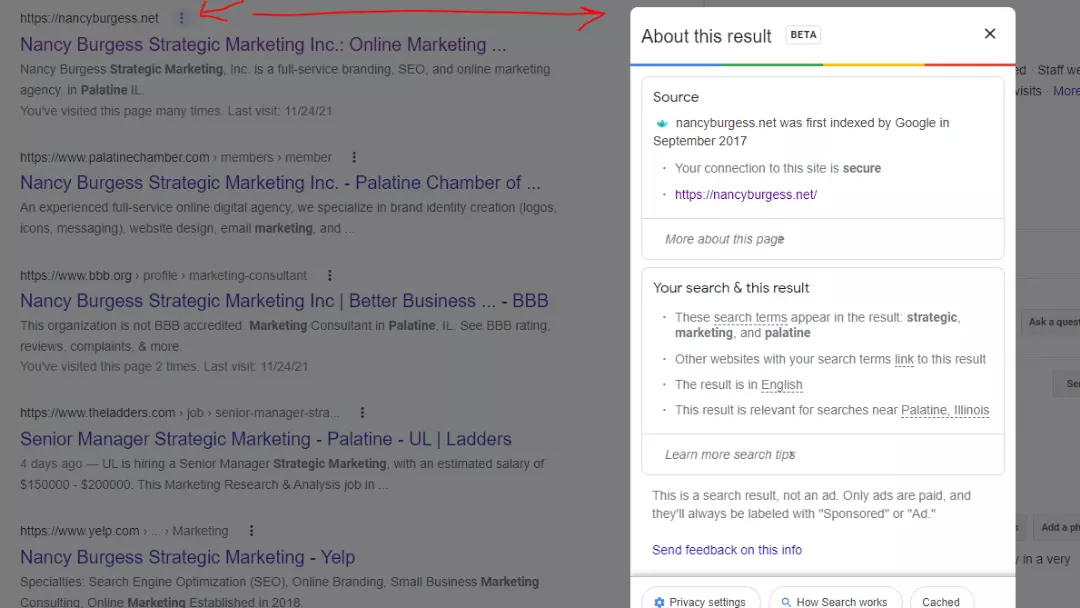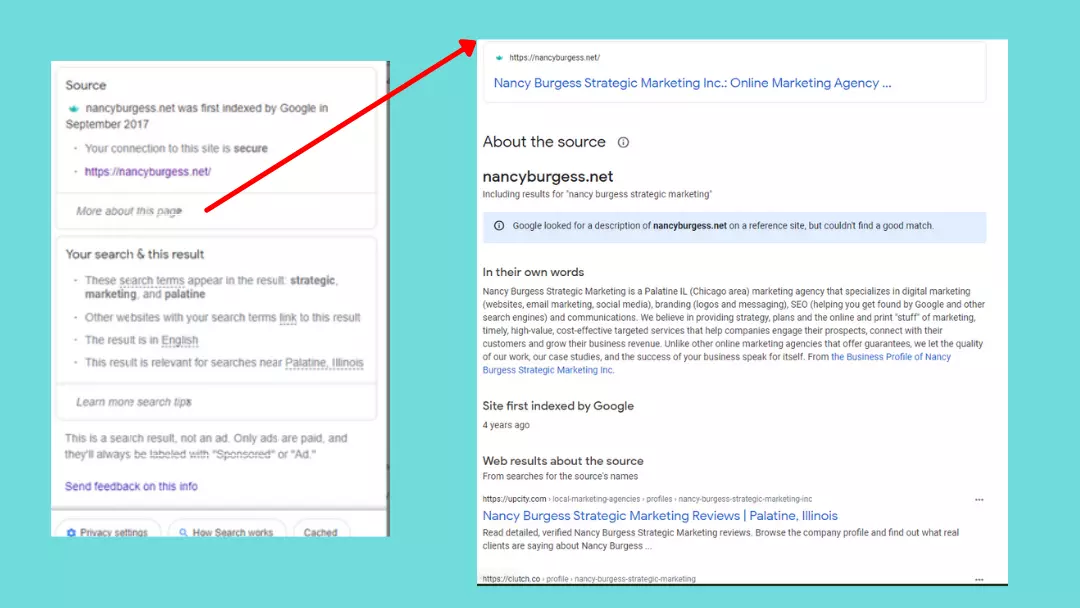If you’re an SMB web designer, it’s important to stay informed about SEO updates. In this article, we summarize some of the most recent SEO updates for SMB web designers and developers.
- Background on SEO for SMBs
- 2021 SEO Updates and Volatility
- Problematic Page Titles Rewrites
- Google’s Search Spam Update
- Continuous Scrolling on Mobile
- New Ecommerce Guidelines
- Product Reviews Update
- Google My Business Changes for SMBs
- Local SEO Algorithm Update: “Vicinity”
- Updated Search Quality Evaluator Guidelines
- Three Dots for Reputation
- The Dreaded Mobile Page Experience Update for SMBs
- Page Experience Coming to Desktop Search in Early 2022
Background on SEO for SMBs
For those SMB web designers who are relatively new to SEO (search engine optimization, we recommend our combination video and/or blog: SEO 101 for Business Owners and Executives. Read or watch to gain a foundation of what SEO is and why it matters.
2021 SEO Updates and Volatility
If it seems that 2021 has been a volatile SEO year with an enormous number of Google algorithm updates, you’re right.
More Numerous 2021 SEO Updates
While 2020 was relatively quiet when it came to SEO algorithm changes, 2021 has exploded with changes. As we’ve mentioned before, Google tweaks its algorithm multiple times a day, but 2021 has seen many more significant SEO updates. Moz has been tracking these algorithm changes for the past 21 years.
In 2020, Google launched only seven confirmed algorithm updates according to Moz. As of November 2021, it had rolled out nine significant algorithm changes.
More Impactful 2021 SEO Updates
What’s more, these changes have created enormous volatility in search rankings, according to Semrush . As reported in Search Engine Land, 2021 brought about 68% more volatility on desktop search and a whopping 85% more volatility on mobile search compared to 2020.
This included not only more days of high and very-high levels of rank volatility, but these swings occurred on more days.
Problematic Page Title Rewrites
In August, Google began to rewrite how page titles (also known as title tags) appeared in search results. Web designers and SEOs were not amused.
As Google’s John Mueller phrased it in Search News, “The initial change resulted in a LOT of feedback…”
Since then, Mueller reports that this rollout has been improved. What’s more, the text shown will no longer vary by query (i.e., by what people “Google”).

Page Title Advice for SMB Web designers
Google offers the following advice for <title> elements:
- Ensure each page HAS a title element.
- Write descriptive and concise text (e.g., not “Home”).
- Avoid keyword stuffing.
- Be relevant: reflect the content of the page.
- Avoid duplicated or boilerplate text.
- Brand your titles concisely.
- Be sure search engines can crawl your page.

Google’s Search Spam Updates
Google has released three confirmed anti-spam updates in 2021. The most recent of these was in November. The July update was specifically called a “link spam update.” It was geared to disqualify links that are generated by link schemes.
Advice for SEOs and SMB Web Designers About Links
In a page last updated at the end of November, Google reminds SEOs and SMB web designers to avoid the following:
- Buying or selling links or posts that contain links
- Exchanging goods or services for links
- “Link to me and I’ll link to you” schemes
- Large scale article marketing or guest posting campaigns
- Automated programs to create links
- Unnatural links generated by advertisements, advertorials, or news releases
Continuous Scrolling on Mobile
Google has rolled out continuous scrolling on mobile devices in the United States. This means that people on their phones or tablets can now easily scroll past the first 10 results, the first 20 results, etc. In other words, users have the ability to see more search engine results (i.e., impressions) without clicking.

The Impact SEOs and SMB Web Designers See With Continuous Scrolling
With this change, you may see a website’s daily impressions increase in the Performance section of Google Search Console.
At the same time, you may also see lower click-thru rates (CTRs). This is because users will readily have more search listings to choose from.
Further, we predict that the more users begin to go to your site, the more Google’s artificial intelligence (AI) may begin to increase your ranking.
On the other hand, if users scroll past your search engine return listing, you may see clicks and average positions decline.
To prompt users to click on the search return listing for your SMB website pages, be sure to write descriptive URLs, follow the title best practices, and include a compelling meta description.
New Ecommerce Guidelines
If you design ecommerce sites for your SMB, be sure to check out Google’s comprehensive guide for ecommerce. We reviewed these guidelines in depth in How to Pay Less for Ecommerce Traffic: Google’s Roadmap Revealed.


Product Reviews Update
Sites with product reviews (affiliate sites) are now held to a higher standard. In other words, an expert must independently evaluate the products and include more than simply manufacturer information.
Google My Business Changes for SMBs
For many SMBs, local search is an extremely important source of website traffic. Foremost in this arena has been Google My Business.
Google My Business is now called Google Business Profile. Additionally, you and your SMB clients can now edit your Google Business Profile directly on Google.
Local Search Algorithm Update: “Vicinity”
On December 16, 2021, Google confirmed that it updated search algorithm factors that affect local search results. Soon after, Brightlocal reported that this change was the biggest local search algorithm update in five years. This local update, now being called “Vicinity,” focuses on proximity. In other words, it strives to make local search results more relevant to the location of the user.
What’s more, on desktop search, the local pack (three-pack of listings) now appears to the left of the map rather than below it.
Google continues to recommend this local ranking guidance:
- Ensure complete data with your physical address, phone number, category, and attributes listed in your Google Business Profile.
- Verify your location.
- Ensure your hours are accurate, including holiday hours.
- Respond to reviews.
- Add photos to your profile.
Additionally, three factors help to ensure your business is listed prominently in the local pack: your relevance to the search (don’t keyword stuff!), your distance from the user, and how well-known you are in the community.
Updated Search Quality Evaluator Guidelines
We’ve discussed a little about the importance of your SMB’s expertise, authoritativeness, and trustworthiness (E-A-T) in What Every Small Business Owner Needs to Know About Content Marketing.
In fact, in Google’s Search Quality Evaluator Guidelines, E-A-T is mentioned 129 times in these 161-page guidelines. The guidelines were most recently updated in October.
YMYL Sites
E-A-T is especially important for your money or your life (YMYL) websites, such as healthcare and financial websites. In October, the definition of YMYL sites has expanded to include:
- News and current events
- Civics, government, and law
- Financial advice
- Shopping
- Health and safety
- Groups of people, including groups based on “race or ethnic origin, religion, disability, age, nationality, veteran status, sexual orientation, gender, or gender identity”

What SMB Web Developers Should Know About E-A-T
In its updated quality rater guidelines, Google suggest that “for individual authors and content creators, biographical information articles can be a good source of reputation information.”
As an SMB web designer, you can help ensure E-A-T, by ensuring a post is written by an individual subject matter expert (SME) author—not “staff writers.”
Also, use extensive author biography pages, says content strategy expert Lily Ray in “E-A-T in Google Search, Google Discover, and Beyond!” Be sure to innovate what goes into the bio. For example, you’ll want to link to other articles or sources online where the author’s expertise is showcased. Including a photo or video is also helpful. Use schema wherever you can to enhance the bio and credentials.
Furthermore, authority is demonstrated by focusing on a specific topic—rather than a wide spectrum of topics.
Ray also noted that the following are important:
- Transparency
- Fact checking
- Evidence-based research
Demonstrate to users and search engines that you’re investing in the quality of the content.
Perhaps display your editorial policy.
“Lowest Page Quality”
Google notes that pages that can cause physical, mental, emotional, or financial harm to people are to be rated as “lowest page quality” sites.
- Sites that doxx users (a type of cyberattack designed to extract private information to use it to shame, extort, and otherwise harass a person)
- Content with instructions for suicide or homicide
- Offensive or dehumanizing stereotypes
- Harmful content or unsubstantiated facts
See the reputation information that Google is including in the three dots (below).
Three Dots in Search for Reputation
Starting in February, the Google search engine return pages (SERPs) now have three dots after the URL. Still in Beta, this feature is intended to help users better understand the website that they’re visiting.
Content varies when you click the three dots.

For the most part, you’ll see a popup with a headline that reads “About this result.” The information varies depending on the website. Generally, you’ll see two main sections:
- Source
- Your search & this results
The “Source” section includes:
“Information about the source” Section
The “Source” section content does the following:
- Indicates when the site was first indexed by Google
- Whether or not the connection to the site is secure (think SSL certificate)
- Includes the complete URL for the page (often it’s truncated in the search returns—especially on mobile)
- Allows you to choose “More about this page >”
Below the “Source” section is the “Your search & this result” section.
“Your search & this result” Section
This “Your Search & this result” section currently shows:
- Search terms that led you to this page
- Terms related to your search in the result
- The websites language
- The location where the searches are most relevant
- Allows you to choose “Learn more search tips”
“More About This Page” Section
The “More about this page” section opens a second popup with the following features:
- Snippet
- About the source
- About the Topic

Snippet
The boxed snippet at the top displays a:
- Favicon
- Complete URL
- Title
“About the source” Section
The “About the source” content includes an excerpt from the “about” page of your website, often called “In their own words.” This seems to support the need for SMB web designers to have “about” page content on their sites.
Furthermore, it may include “web results about this source.” The latter provides a few sources that link to you.
Finally, it notes how long ago the SMB site was first indexed by Google.
“About the topic” Section
The “About the topic” section includes related results. The user can click at the bottom to load more results.
The Dreaded Mobile Page Experience Update for SMBs
As we reported in our blog Google Algorithm Updates in 2021: What Small Businesses Need to Know, the Page Experience update looks at:
- Mobile friendliness
- Safe browsing
- Secure sites (SSL)
- Avoiding annoying popups (intrusive interstitials)
- Core web vitals
The Elusive Core Web Vitals Update
For many SMB web designers, the most elusive of these ranking factors tends to be the core web vitals, which address site speed, responsiveness, and interactivity through three factors:
- Largest Contentful Paint (LCP): within 2.5 seconds
- First Input Delay (FID): less than 100 milliseconds
- Cumulative Layout Shift (CLS): score less than 0.1
If you wish to delve further, click on the links above or watch our short video: Google SEO Changes in 2021.
Page Experience for SMB websites
For most SMBs, web designers and SEOs won’t find any data in the Page Experience section of Google Search Console. Instead, you’ll find a message that reads that the website has not received enough site traffic in the last 90 days for a complete evaluation.
For those SMBs with “enough usage data,” page experience is based on an aggregate of real user experiences over time—not lab data.
What’s an SMB web designer to do?
Steps to Take When Building an SMB Website From Scratch
When you have the opportunity to build a new SMB site:
- Select a fast host.
- Choose a lightweight theme.
- Be sure to optimize your images for the web.
- Use a CDN.
- Avoid loading your SMB website down with too many plugins.
- Become more fluent in web development code, using code rather than a plugin when able.
Test Your Existing and Developing SMB Website Pages
As an SMB web designer, you can test the approximate speed of individual mobile and/or desktop pages yourself with PageSpeed Insights and/or Google Chrome’s developer tools (under Chromes three vertical dots > More tools > Developer tools).
You’ll get an overall speed score number (not directly related to your ranking) as well as LCP and CLS scores. You will not find an FID.
These tests offer specific recommendations for improvement, called “opportunities” and “diagnostics.” What’s more, they let you know what’s going well in its “passed audits” section.
The Impact on SMB Websites
In my opinion, this algorithm update (particularly the core web vitals) gives an unfair advantage to the largest, wealthiest companies that can afford to hire high-tech coders to improve their Core Web Vitals.
Also, Google Search Console provides feedback to large sites (with “enough” user experience data). By contrast, SMB web designers need to test each page individually. And you’ll get lab data—not actual user experience data. (Only user experience data is considered in Core Web Vitals.)
Happily, more and more WordPress theme developers and other website builders have begun to focus on making builders and themes lighter and faster.
How Important Are the Core Web Vitals?
At one point this year, John Mueller of Google reported that all other factors being equal between two websites, core web vitals would be a deciding factor.
In November, however, he stated that the factor was “more than just a tie breaker.” In both cases, he reiterated that it was most important for website designers and SEOs to focus on the value of the entire website.
Keep in mind that the Core Web Vitals are one ranking factor among more than 100+. What’s more, the Core Web Vitals are not the primary or most critical search ranking factor.
That’s because many other factors, such as relevant content creation, is still critical to having a fantastic SMB website.
For example, a web page with little to no content will load very quickly. However, it will likely not rank well, because it offers little to no value.

Page Experience Coming to Desktop Search in Early 2022
At the same time, Page Performance and the Core Web Vitals are not going away.
In fact, Page Performance Updates are coming to desktop search in February to March 2022. All of the factors will apply to desktop sites except, of course, mobile friendliness.
Summary
To be effective in 2022 and beyond, SMB web designers will need to be familiar with these Google updates. At Nancy Burgess Strategic Marketing Inc., we stay apprised of Google updates, so we can help our SMB clients and our web designer colleague’s websites be optimized for search.
Learn more about our SEO Services for SMBs and our SEO Services for Web Designers and Developers.
Nancy Burgess


